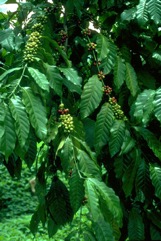Coffee (Robusta)

A tropical plant. It grows more in the lowland tropics. It occurs naturally in rain-forests in Africa from 10°S & N of the equator and from sea level to 1,600 m altitude. In PNG it is mostly below 550 m above sea level. It grows in areas with rainfall from 1000 to 2,500 mm per year. Temperatures in the range 18°C to 32°C are suitable. It suits hardiness zones 10-12. In XTBG Yunnan.
Also known as:
Cafeto Robusto, Congo coffee, Kafi, Kapeng barako, Quillow coffee
Synonyms
- Coffea bukobensis A. Zimm.
- Coffea canephora var. kouilouensis Pierre ex De Wild.
- Coffea canephora var. sankuruensis De Wild.
- Coffea robusta Linden
- Coffea laurentii De Willd.
- Coffea maclaudii A.Chev.
Edible Portion
- Seeds - drink, Fruit, Spice
Where does Coffee (Robusta) grow?
Found in: Africa, Asia, Angola, Australia, Benin, Brazil, Cameroon, Central Africa, Central African Republic, CAR, Central America, China, Congo DR, Cook Islands, Costa Rica, Côte d'Ivoire, East Africa, East Timor, Fiji, Gabon, Guam, Guinea, Guinée, India, Indochina, Indonesia, Ivory Coast, Mozambique, Myanmar, New Caledonia, Nigeria, Pacific, Palau, Papua New Guinea, PNG, Philippines, SE Asia, Sierra Leone, Solomon Islands, Sudan, Tanzania, Thailand, Timor-Leste, Uganda, Vanuatu, Vietnam, West Africa, West Timor
Notes: There are about 40 Coffea species. In Botanical Gardens in Slovenia presumably in a hot house.
Growing Coffee (Robusta)
Cultivation: Many plants are grown from seed. They can be grafted onto other rootstock. If clonal cuttings are used, two different clones need to be planted together to ensure good pollination. Plants are spaced at 3 m by 3 m. Light shade is normally helpful. Several of the upright stems are allowed to grow, because some side branches die off.
Edible Uses: The seeds are used for coffee. They are roasted. In some places the fruit are lightly boiled then chewed.
Production: Plants are cross pollinated. It takes 9-10 months from flowering to harvest. One harvest is made, picking dried cherries off the tree. These are then dried and hulled.
Nutrition Info
per 100g edible portion| Edible Part | Energy (kcal) | Protein (g) | Iron (mg) | Vitamin A (ug) | Vitamin c (mg) | Zinc (mg) | % Water |
|---|---|---|---|---|---|---|---|
| - | - | - | - | - | - |
Coffee (Robusta) Photos

References
Ambasta, S.P. (Ed.), 2000, The Useful Plants of India. CSIR India. p 135 (As Coffea robusta)
Anderson, E. F., 1993, Plants and people of the Golden Triangle. Dioscorides Press. p 207
Barwick, M., 2004, Tropical and Subtropical Trees. A Worldwide Encyclopedic Guide. Thames and Hudson p 125
Bourret, D., 1981, Bonnes-Plantes de Nouvelle-Caledonie et des Loyaute. ORSTOM. p 23 (As Coffea robusta)
Brouk, B., 1975, Plants Consumed by Man. Academic Press, London. p 345
Burkill, H. M., 1985, The useful plants of west tropical Africa, Vol. 4. Kew.
Burkill, I.H., 1966, A Dictionary of the Economic Products of the Malay Peninsula. Ministry of Agriculture and Cooperatives, Kuala Lumpur, Malaysia. Vol 1 (A-H) p 635
Cobley, L.S. (rev. Steele, W.M.) 2nd Ed., 1976, An Introduction to the Botany of Tropical Crops. Longmans. p 207
Dalziel, J. M., 1937, The Useful plants of west tropical Africa. Crown Agents for the Colonies London.(As Coffea maclaudii and Coffea robusta)
Etherington, K., & Imwold, D., (Eds), 2001, Botanica's Trees & Shrubs. The illustrated A-Z of over 8500 trees and shrubs. Random House, Australia. p 220
Facciola, S., 1998, Cornucopia 2: a Source Book of Edible Plants. Kampong Publications, p 212
Ferwerda, F.P., 1979, Coffees, in Simmonds, N.W., (ed), Crop Plant Evolution. Longmans. London. p 257
French, B.R., 2010, Food Plants of Solomon Islands. A Compendium. Food Plants International Inc. p 312
Grivetti, L. E., 1980, Agricultural development: present and potential role of edible wild plants. Part 2: Sub-Saharan Africa, Report to the Department of State Agency for International Development. p 27 (As Coffea maclaudii)
Hu, Shiu-ying, 2005, Food Plants of China. The Chinese University Press. p 679
Kiple, K.F. & Ornelas, K.C., (eds), 2000, The Cambridge World History of Food. CUP p 1760
Latham, P., 2004, Useful Plants of Bas-Congo province. Salvation Army & DFID p 86
Llamas, K.A., 2003, Tropical Flowering Plants. Timber Press. p 325
Notizbl. Koenigl. Bot. Gart. Berlin 1:230, 232. 1897
Purseglove, J.W., 1968, Tropical Crops Dicotyledons, Longmans. p 482
Small, E., 2009, Top 100 Food Plants. The world's most important culinary crops. NRC Research Press. p 207
Sukarya, D. G., (Ed.) 2013, 3,500 Plant Species of the Botanic Gardens of Indonesia. LIPI p 616
Sukenti, K., et al, 2016, Ethnobotanical study on local cuisine of the Sasak tribe in Lombok Island, Indonesia. Journal of Ethnic Foods. 3 (2016) 189-200 p 198
Vivien, J., & Faure, J.J., 1996, Fruitiers Sauvages d'Afrique. Especes du Cameroun. CTA p 293
von Katja Rembold, 2011, Conservation status of the vascular plants in East African rain forests. Dissertation Universitat Koblenz-Landau p 162
Walter, A. & Lebot, V., 2007, Gardens of Oceania. ACIAR Monograph No. 122. CD-ROM minor species p 10
Wiriadinata, H., 1995, Ethnobotany of Economic Plants in the Baliem Valley, Jayawijaya, Irian Jaya, Indonesian Institute of Science, Bogor, Indonesia (As Coffea robusta)
World Checklist of Useful Plant Species 2020. Royal Botanic Gardens, Kew
Zuchowski W., 2007, Tropical Plants of Costa Rica. A Zona Tropical Publication, Comstock Publishing. p 195